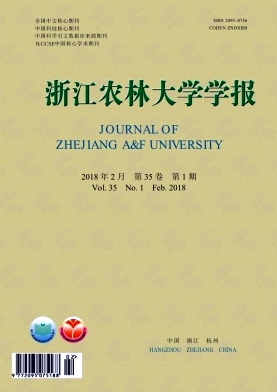-
香榧Torreya grandis ‘Merrillii’是红豆杉科Taxaceae榧属Torreya榧树Torrent grandis经人工选育和嫁接繁殖栽培的优良变异品种。香榧的实生亲代性状易出现分离或变异,不能保持优良单株的栽培和品质特性[1];生产上多用嫁接繁殖,常见方法是用2年生以上的实生大苗进行嫁接,也有的用种砧嫁接法嫁接[2-5]。但传统方法采穗困难、嫁接速度慢、嫁接受季节限制等问题,使得香榧繁殖系数低、育苗成本高,制约了香榧产业的发展。近年来,有人将组培得到的香榧优株枝段用腹接法嫁接到当年播种的实生砧木上,即进行嫩枝嫁接[6-7],可使其成活率达83.3%,为香榧开展微型嫁接作了有益的探索。微型嫁接是指把母株或试管苗上切取的茎尖嫁接到幼苗或试管苗上的嫁接技术,该技术早见于草本植物的茎尖嫁接,20世纪70年代MURASHIGE等[8]将其应用到木本植物的脱病毒植株的培养上,随后陆续在腰果Anacardium occidentale[9]和马来沉香Aquilaria malaccensis[10]上得到应用;在中国,该项技术主要应用于柑橘Citrus reticulate[11-12],梨Pyrus bretschneideri[13],樱桃Prunus avium[14-15]等果树的育种和高品质苗木大量快速繁殖,在针叶树种尤其是香榧中鲜见报道。本研究探讨了不同微型嫁接方法、接穗留叶数量、顶端去留等措施对香榧嫁接苗成活和生长的影响,提高香榧良种繁殖系数,降低育苗成本,实现工厂化育苗,为探索香榧良种快繁新技术,解决香榧生产上良种苗木供应短缺的问题提供理论和实践基础。
HTML
-
试验所用砧木来自浙江省杭州市临安野草农业开发有限公司的香榧育苗基地。于2015年10月采收榧树种子,采用塑模拱棚、湿毛毡布覆盖层积催芽;翌年1月,挑选刚露胚根或种壳开裂种子播种到无纺布营养钵中;即将展叶时,选取生长势相对一致的榧树实生小苗备用。
-
试验所用接穗采自浙江农林大学香榧基地。于2016年4月在香榧母树上采集未形成顶芽、未木质化或半木质化的当年生嫩枝作接穗,截取长度为2~3 cm,留叶4~6片,一半保留顶端,另一半摘除顶端,随采随接。
-
本试验采用劈接(图 1A),钻孔接(图 1B)和腹接(图 1C)等3种微型嫁接方法,60株·方法-1。①砧木处理。采用劈接和钻孔接时,先将榧树实生小苗距离幼茎基部2~3 cm处剪断、削平;劈接时用刀片沿砧木中间向下切1 cm长的切口;钻孔接时用镊子从上而下垂直在砧木中间钻出孔径1 mm,深1 cm的小孔。腹接时砧木不剪,在离幼茎基部2~3 cm处用刀片从上而下斜切至中部,切口长约1 cm。②接穗处理。劈接用接穗,将香榧穗条用11号手术刀片削成两面等长、削面长约1 cm的楔形;钻孔接时将接穗削成圆锥形;腹接用穗条削成一面长、另一面短的马耳形。③插穗包扎。将处理好的穗条插入切开的砧木中,用宽约1 cm的保鲜膜将接口捆严绑紧。④接后管理。将嫁接苗置于装有基质湿度为90%左右条件一致的育苗盒里自然生长,统一管理。腹接苗待到接穗萌动后截掉砧木上部。
-
① 留叶数量。分别设置在穗条上留2,4,6片叶片等3种处理。②顶部处理。设置穗条摘顶和穗条留顶2种处理。③嫁接时间。为保证试验结果的重复性,在4月14日首次嫁接后,于4月15日,4月18日又进行2次嫁接,共3次重复。
-
嫁接苗于嫁接当天测量接穗高度、接穗粗度和砧木粗度。在嫁接后15,30,45和60 d记录嫁接苗新梢萌发情况;90 d后,考虑到嫁接苗成活率,随机选取30株再次测量,并记录其新增枝条数、新增叶片数和新茬数。嫁接后1 a,对不同接穗类型嫁接苗的地径,苗高和新茬数进行测定比较。
-
记录不同留叶数量的嫁接苗株数,同时记录嫁接速率(株·h-1);45 d后调查成活株数,并统计成活率,计算嫁接工效。
-
采用Excel 2010对所测数据进行整理及图表绘制,用软件SPSS 17.0对数据进行方差分析,利用最小显著差(LSD)法进行多重比较。
1.1. 试验材料
1.1.1. 砧木准备
1.1.2. 接穗采集
1.2. 试验方法
1.2.1. 嫁接方法[16]
1.2.2. 接穗类型
1.3. 指标测定
1.3.1. 接穗萌发动态及生长量测定
1.3.2. 嫁接成活率观测
1.4. 数据处理及分析
-
不同嫁接方法下嫁接苗萌发动态的观测结果见表 1。嫁接15 d内,多数嫁接苗均未萌动,特别是钻孔接苗,全部处于未萌动状态;15 d后,劈接和腹接接穗已有少量露白迹象,说明这些嫁接苗已经成活并且开始生长;此时钻孔接的嫁接苗还未露白,说明采用此法嫁接的接穗与砧木之间的愈合时间较长,恢复生长较迟缓。嫁接30 d后,钻孔接苗虽然已有部分穗条开始萌动,但未萌动的比例仍然很高;嫁接45 d后,劈接苗和腹接苗多数都已萌动,说明此时大多数嫁接苗已成活萌发,但只有劈接苗出现展叶现象。嫁接60 d后,劈接苗都已展叶,钻孔接苗和腹接苗还剩少数没有露白。整体来看,用劈接法接穗萌发生长最快,腹接次之,钻孔接最慢。
嫁接方法 比例/% 培育时间/d 未萌动 露白 萌芽 展叶 劈接 15 93.3 697 - - 30 53.3 3697 10.0 - 45 40.0 4393 1393 393 60 - - - 100.0 钻孔接 15 100.0 - - - 30 80.0 1393 697 - 45 70.0 20.0 10.0 - 60 36.7 4393 20.0 - 腹接 15 9697 393 - - 30 7394 2393 393 - 45 23.3 70.0 697 - 60 6.7 5393 2697 1393 说明:"-"表示未出现。 Table 1. Germination of different micrografting seedlings of Torreya grandis ‘Merrillii’
不同微型嫁接方法下嫁接苗的生长动态如表 2所示。劈接苗的接穗新梢生长量最大,腹接法次之,不同嫁接方法的差异显著(P<0.05)。钻孔接的嫁接苗新萌发枝梢的粗度较粗,与另2种嫁接方法差异显著(P<0.05)。腹接苗砧木粗度增长最快,显著高于劈接和钻孔接(P<0.05)。在新增枝条数和新茬数上,不同方法之间无显著差异。不同嫁接方法对嫁接苗新增叶片数的影响达到显著水平(P<0.05),腹接苗新增叶片数最多,劈接次之,钻孔接最少。由此认为,用劈接法嫁接的苗木前期生长较快,较其他方法更适宜香榧微型嫁接繁殖。
嫁接方法 新梢高度/cm 新梢茎粗/mm 砧木增粗/mm 新枝数/个 新茬数/茬 增加叶片数/片 劈接 8.16 ± 0.48 a 1.14 ± 0.13 b 0.45 ± 0.03 b 1.80 ± 0.05 a 1.37 ± 0.11 a 53.80 ± 2.26 b 钻孔接 4.58 ± 0.19 c 1.28 ± 0.19 a 0.52 ± 0.05 b 2.60 ± 0.06 a 1.20 ± 0.14 a 48.00 ± 2.70 c 腹接 6.15 ± 0.40 b 1.18 ± 0.16 b 0.84 ± 0.03 a 2.07 ± 0.07 a 1.40 ± 0.13 a 69.27 ± 2.73 a 说明:不同字母表示在0.05水平上差异显著。 Table 2. Growth indexes of different micrografting seedlings of Torreya grandis ‘Merrillii’
图 2为嫁接苗培育一定时间后的枝梢生长形态(拍摄于2016年11月25日)。由图 2可知:劈接香榧苗在生长高度上有优势,腹接香榧苗存在顶芽五分枝生长现象,而钻孔接香榧苗新生嫩枝生长较为分散。
-
接穗是否保留顶端对香榧微型嫁接苗生长动态也有影响,图 3显示:接穗保留顶端的嫁接苗于嫁接后15 d就出现顶芽萌动迹象,并在后期生长中出现较多不定芽;而接穗摘除顶端的嫁接苗在嫁接后30 d左右才有不定芽开始萌动。表 3为培育1 a后的嫁接苗生长动态观测图,发现接穗保留顶端与否对嫁接苗地径和新茬数的生长无明显差异,但就苗高而言,摘除顶端的嫁接苗要显著高于保留顶端的嫁接苗。
地径/mm 苗高/cm 新茬数/茬 保留顶端 2.99 ± 0.11 a 9.79 ± 0.58 b 2.15 ± 0.08 a 摘除顶端 3.21 ± 0.15 a 13.14 ± 1.26 a 2.20 ± 0.20 a 说明:不同字母表示在0.05水平上差异显著。 Table 3. Growth of micrografting seedlings with/without crown after 1 year
-
嫁接45 d后,不同嫁接方法、不同留叶数量嫁接苗的成活率统计结果见表 4。劈接法接穗留叶数为4片时,嫁接苗成活率最高,达97.8%;腹接法接穗留叶数为6片时,嫁接苗的成活率达到了86.7%;无论哪种方法嫁接,接穗留叶2片的嫁接苗成活率都是最低的。综合来看,劈接法平均成活率最高,达到了89.7%,显著高于其他方法。不同嫁接方法在嫁接速率上差异不显著,但在嫁接工效上劈接法明显高于钻孔接法和腹接法,说明劈接技术容易掌握、便于操作。由此可以认为,较另2种嫁接方法而言,劈接法更适用于香榧的微型嫁接。
嫁接方法 保留叶片/片 嫁接株数/株 成活株数/株 成活率/% 平均成活率/% 嫁接速率/(株·h-1) 嫁接工效/(株·h-1) 劈接 2 45 36 80.0 c 4 45 44 97.8 a 89.7 a 40 35.88 6 45 41 91.1 b 钻孔接 2 20 12 60.0 b 4 25 17 68.0 a 66.0 b 36 23.76 6 20 14 70.0 a 腹接 2 30 12 40.0 c 4 30 23 76.7 b 68.0 b 39 26.52 6 30 26 86.7 a 说明:不同字母表示在0.05水平上存在显著差异。嫁接工效=嫁接速率×嫁接成活率/100。 Table 4. The survival statistics of different micrografting seedling in Torreys grandis ‘Merrillii’
2.1. 不同嫁接方法对嫁接苗萌发生长的影响
2.2. 接穗顶端保留与否对嫁接苗生长动态的影响
2.3. 不同微型嫁接方法对嫁接成活率的影响
-
相比于传统嫁接法应用2年生以上实生苗和生长1 a的穗条,微型嫁接法所用砧穗均取自当年,可有效缩短良种苗木培育时间,劳动强度低、可操作性强,且嫁接不受时间限制,具有很好的应用前景。与沉香Aguilaria sinensis的最适微型嫁接法研究结果不同[8],本试验中,劈接法在嫁接苗生长量、成活率、嫁接工效上都高于钻孔接法和腹接法,且萌动较早,苗高生长量较大,因此,可认为是香榧微型嫁接的最佳选择。
接穗留叶4~6片的微型嫁接成活率较高,与苹果Malus domestica试管微嫁接保留叶片2~4片为宜的研究结果较为一致[17],说明不同树种微型嫁接时接穗保留一定数量叶片有利于提高嫁接成活率,这可能与叶片功能有关,具体机制有待于进一步研究。对香榧微型嫁接苗生长的长期监测发现,保留顶端的嫁接苗萌芽较早,但后期苗高的生长显著低于摘除顶端的嫁接苗。因此,就长期生长来看,采用穗条摘除顶端的处理技术不仅可以培育高质量的苗木,而且可提高接穗利用率,降低对母树的影响,大大减低育苗成本。
本研究为香榧微型嫁接提供了方法和实践探索,填补了香榧良种栽培微型嫁接技术的空白,但砧苗培养、嫁接时间、激素应用等诸多因素需要深化研究,将进一步探索香榧微型嫁接苗的愈合机制和调控措施,构建香榧良种工厂化快速繁殖技术体系。










 DownLoad:
DownLoad: